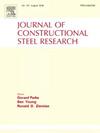Research on out-of-plane cyclic behavior of unilateral stainless steel composite shear walls
IF 4
2区 工程技术
Q1 CONSTRUCTION & BUILDING TECHNOLOGY
引用次数: 0
Abstract
To investigate the out-of-plane load-bearing behavior of unilateral stainless steel double steel plate composite shear walls (USCW), a total of eight specimens were designed and divided into two distinct groups based on wall-thickness scale ratios of 1:5 and 1:2.5, with corresponding width-to-thickness ratios of 6 and 4, respectively. The specimens were tested under out-of-plane cyclic loading, where an axial compression ratio of 0.1 was maintained. The failure modes, hysteretic behavior, stiffness degradation, and energy dissipation of USCW were also analyzed, as well as the effects of stud reduction. Results indicated that all specimens primarily presented bending failure modes. There is no significant difference in bearing capacity degradation, ductility, and energy dissipation capacity between USCW and SCW. For USCW specimens with equal-strength steel plates on both sides, the bearing capacity difference between the two loading directions is 2 %, whereas for USCW with equal-thickness steel plates, it reaches 17.8 %. The equal-strength specimens exhibited better symmetry in bearing capacity and ductility. The reduction of the number of studs through increasing the stud spacing by 50 % had a minor impact of less than 10 % on the ductility and load-bearing capacity of USCW. Unilateral heating conditions had a negligible effect on the out-of-plane bearing performance of USCW. Furthermore, when the walls primarily experience flexural-shear failure dominated by bending, a formula for the out-of-plane bending capacity of USCW is proposed. This formula takes into account the influence of the differences in the steel plates on the two sides as well as the shear effect.
求助全文
约1分钟内获得全文
求助全文
来源期刊

Journal of Constructional Steel Research
工程技术-工程:土木
CiteScore
7.90
自引率
19.50%
发文量
550
审稿时长
46 days
期刊介绍:
The Journal of Constructional Steel Research provides an international forum for the presentation and discussion of the latest developments in structural steel research and their applications. It is aimed not only at researchers but also at those likely to be most affected by research results, i.e. designers and fabricators. Original papers of a high standard dealing with all aspects of steel research including theoretical and experimental research on elements, assemblages, connection and material properties are considered for publication.
 求助内容:
求助内容: 应助结果提醒方式:
应助结果提醒方式:


